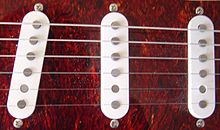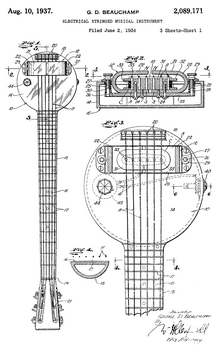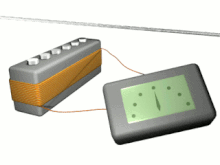Single coil guitar pickup: Difference between revisions
Busterdawg (talk | contribs) →Beauchamp: no mention of the Bill Lawrence pickup is needed considering it's also similar to about a dozen other pickups. |
|||
| Line 10: | Line 10: | ||
In the mid 1920s [[George Beauchamp]], a Los Angeles, California guitarist, began experimentation with electric amplification of the guitar. Originally using a phonograph pickup assembly, Beauchamp began testing many different combinations of coils and magnets hoping to create the first electromagnetic guitar pickup. He wound his earliest coils using a non-too-delicate motor out of a washing machine, later on switching to a sewing machine motor, and eventually using single coiled magnets. |
In the mid 1920s [[George Beauchamp]], a Los Angeles, California guitarist, began experimentation with electric amplification of the guitar. Originally using a phonograph pickup assembly, Beauchamp began testing many different combinations of coils and magnets hoping to create the first electromagnetic guitar pickup. He wound his earliest coils using a non-too-delicate motor out of a washing machine, later on switching to a sewing machine motor, and eventually using single coiled magnets. |
||
Beauchamp was backed in his efforts by [[Adolph Rickenbacker]], an engineer and wealthy owner of a successful tool and die business. Beauchamp eventually produced the first successful single coil pickup. The pickup consisted of two massive "U" shaped magnets and one coil and was given the name, the horseshoe pickup. The two horseshoe shaped magnets surrounded the strings that passed over a single core plate(or blade) in the center of the coil |
Beauchamp was backed in his efforts by [[Adolph Rickenbacker]], an engineer and wealthy owner of a successful tool and die business. Beauchamp eventually produced the first successful single coil pickup. The pickup consisted of two massive "U" shaped magnets and one coil and was given the name, the horseshoe pickup. The two horseshoe shaped magnets surrounded the strings that passed over a single core plate(or blade) in the center of the coil. |
||
Beauchamp outfitted the pickup in a custom built lap slide guitar. The production model that descended from this prototype became the Hawaiian Electro [[lap steel guitar]], nicknamed the "Frying Pan" for it’s round, flat body. |
Beauchamp outfitted the pickup in a custom built lap slide guitar. The production model that descended from this prototype became the Hawaiian Electro [[lap steel guitar]], nicknamed the "Frying Pan" for it’s round, flat body. |
||
Revision as of 23:41, 28 December 2007

A single coil pickup is a type of magnetic transducer for the electric guitar and the electric bass. It electromagnetically converts the vibration of the strings to sound.
History
Beauchamp

In the mid 1920s George Beauchamp, a Los Angeles, California guitarist, began experimentation with electric amplification of the guitar. Originally using a phonograph pickup assembly, Beauchamp began testing many different combinations of coils and magnets hoping to create the first electromagnetic guitar pickup. He wound his earliest coils using a non-too-delicate motor out of a washing machine, later on switching to a sewing machine motor, and eventually using single coiled magnets.
Beauchamp was backed in his efforts by Adolph Rickenbacker, an engineer and wealthy owner of a successful tool and die business. Beauchamp eventually produced the first successful single coil pickup. The pickup consisted of two massive "U" shaped magnets and one coil and was given the name, the horseshoe pickup. The two horseshoe shaped magnets surrounded the strings that passed over a single core plate(or blade) in the center of the coil.
Beauchamp outfitted the pickup in a custom built lap slide guitar. The production model that descended from this prototype became the Hawaiian Electro lap steel guitar, nicknamed the "Frying Pan" for it’s round, flat body. In 1931 Beauchamp founded the Ro-Pat-In Company with Rickenbacker and associates (Ro-Pat-In eventually became the The Electro String Instrument Corporation and subsequently the Rickenbacker International Corporation). The company introduced its first "Electro-String Instruments" to the public in 1932.
Gibson
The Gibson Guitar Corporation introduced the "bar pickup" in 1935 for its new line of Hawaiian lap steel guitars. The pickup's basic construction is that of a metal blade inserted through the coil as a shared pole piece for all the strings. A pair of large flat magnets were fastened below the coil assembly.
In 1936 Gibson introduced the ES-150, its first electric Spanish styled guitar. The ES-150 was outfitted with the bar pickup. Jazz guitar innovator, Charlie Christian, began playing an ES-150 in the late 1930s with the Benny Goodman Orchestra. This caused the popularity of the electrified guitar to soar. Due to Christian’s close association with the ES-150 it began being referred to as the “Charlie Christian Model” and Gibson’s now famous bar pickup as the “Charlie Christian pickup” or “CC unit”.
Sound

The sound of a single coil pickup can range from the dark and fat midrange sound of the Gibson P-90 to the bright and clear Fender Stratocaster single-coil tone.
Common designs
Gibson P-90

The P-90 is a single coil pickup designed by the Gibson Guitar Corporation. These pickups have a large flat coil with adjustable steel screws as pole pieces, and a pair of flat alnico bar magnets lying under the coil bobbin. The adjustable polepieces pick up the magnetism from the strings. There are 2 major varieties of P-90 pickup that differ mainly by mounting options:
- Soap bar casing has true rectangular shape and the mounting screws are contained within the coil perimeter, positioned between the pole pieces, between strings 2-3 and 4-5, thus creating irregular and somewhat unusual pattern. Occasionally they are mistaken for pole pieces, thus sometimes P-90 is erroneously said to have 8 pole pieces. The "soap bar" nickname most probably comes from its predominantly rectangular shape and proportions, and the fact that the first P-90s on the original Gibson Les Paul Model of 1952 were white.
- Dog ear is a casing type with extensions at both sides of pickup that somewhat resemble dog's ears. These are extensions of the predominantly rectangular cover that encompass the outlying mounting screws. Dog-ear P-90 pickups were commonly mounted on Gibson's semi-hollowbody guitars like the ES-330 and occasionally on solid body models like the Les Paul Junior. The same pickups were also available on Epiphone models (since Gibson was building Epiphone guitars in the 1950s) and the design is best remembered for its appearance on the hollow body Epiphone Casino of the mid to late 1960s.
Sound of P-90 is somewhat brighter and more transparent than a later Gibson pickup, a humbucker, though not quite as crisp and snappy as Fender's single coil pickups.
Telecaster design
The Fender Telecaster features two single-coils. The neck pickup produces a mellower sound, while the bridge pickup produces an extremely twangy, sharp tone with exaggerated treble response, because the bridge pickup is mounted on a steel plate. These design elements allow musicians to emulate steel guitar sounds, making it particularly appropriate for country music.
Pickups are selected with a 3-position switch, and two wiring schemes exist:
- Vintage: 1) neck pickup with treble cutoff for a bassier sound; 2) neck pickup only; 3) bridge pickup only.
- Modern: 1) neck pickup only, with no treble cutoff; 2) neck and bridge; 3) bridge pickup only.
The Fender Esquire has a variation to the Vintage wiring scheme by using the scheme on a single pickup. This gives a treble cutoff in the neck position, normal in the middle position, and a tone control cutoff in the bridge position.
Stratocaster design

The traditional Stratocaster design guitar features three single-coils. The guitarist can control what pickup or pickup combination to activate with a lever switch. They are usually referred to as the bridge, middle and neck pickups based on their proximity to those parts of the instrument.
Pickup position, number of coil winds, wire types, magnets and other factors shape the tone. Pickups in the neck position usually give louder, mellower and warmer sound, while bridge pickups have lower output and produce a brighter, sharper and more harmonic-rich tone. The reason the neck pickup has the most output is that the string's vibration has a higher amplitude at the neck position. Thus, the bridge pickup has less output than the neck pickup. Some manufacturers overwind the bridge pickup for more output to compensate for this difference.
The poles have different heights. This staggering is done to compensate for the output of each string for two reasons. The first reason is because the fretboard has a radius (also called camber) of between 7 and 12 inches. Naturally the strings will follow the radius of the fretboard and so must the magnets, generally speaking. The second reason is that some strings have naturally higher output, the plain or unwound G string being the most significant and this calls for these magnets to be further compensated, resulting in an apparent odd looking stagger. Fender Strat pickups generally follow the traditional design and have the G string's magnet as high as the D string's, but this causes the G string to overly dominate all the other strings due to its higher output. Traditionally in the 1950s and 1960s, string sets came with a wound G string, but it was difficult to bend across the fretboard in modern rock and blues styles of music. In the 1970s, string manufacturers introduced the non-wound G string, which was easier to bend, but had a much higher output. In order for the G string to have the same output the G pole should have the greatest gap between the string.
The pickup selection switch has 5 positions. Positions 1, 3 and 5 activate only one pickup (bridge, middle or neck respectively), while positions 2 and 4 activate a combination of two pickups (bridge and middle, or middle and neck, respectively). Some pickup sets have a reverse wound and reverse polarity middle pickup that when in combination with the normal bridge or neck pickups will cancel electromagnetic interference (noise/hum). The sonic effect of positions 2 and 4 is sometimes referred to as a "quack", and some guitar notation includes directions to use these pickup combinations. One example is "Sultans of Swing" by Dire Straits which is played in position 2 (bridge and middle)[1]. Early Stratocasters had only a three-way selector, but innovative guitarists (e.g. Rory Gallagher) found they could get an interesting tone by carefully balancing the selector switch lever between positions. Later on, Fender introduced the now standard 5 way selector switch.
Notable single-coil pickups
There are several well-known single-coil pickups that have a distinctive sound:
- Gibson bar pickup (1935) - later called the Charlie Christian pickup (1938)
- Gibson P-90 (1946)
- Danelectro Lipstick
- Lace Sensor pickups (1987)
- Kinman Hx, patented noiseless passive Fender-like pickups by Kinman Guitar Electrix (1997)
- Fender Vintage Noiseless pickups (1998)
- Rickenbacker pickups (including the "Hi-Gain")
- Gretsch pickups (including the "DynaSonic")
- DeArmond pickups (found on various 60's guitars by various manufacturers but produced by the DeArmond pickup company, now made by Fender; including the 2K and 2000)
See also
References
- ^ Steve Cobham (1997). "NECK AND NECK - Gibson Les Paul and Fender Strat Compared". Sound On Stage.
{{cite journal}}: Unknown parameter|month=ignored (help)
- Batey, Rick (2003). The American Blues Guitar. Hal Leonard. ISBN 063402759X.
- Duchossoir, A. R. (1998). Gibson Electrics: The Classic Years. Hal Leonard. ISBN 0793592100.
- Millard, Andre (2004). The Electric Guitar: A History of an American Icon. Johns Hopkins University Press. ISBN 0801878624.
- Hirst, Tom (2003). Electric Guitar Construction. Hal Leonard. ISBN 1574241257.
- Smith, Richard R. (1987). The History of Rickenbacker Guitars. Centerstream Publications. pp. 9–14. ISBN 0931759153.
{{cite book}}: Cite has empty unknown parameter:|coauthors=(help) - Fjestad, Zachary R. (2005). Blue Book of Electric Guitars. Blue Book Publications, Inc. p. 397. ISBN 1886768579.
{{cite book}}: Cite has empty unknown parameter:|coauthors=(help)
External links
- The history of Gibson pickups [1]
